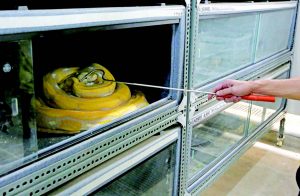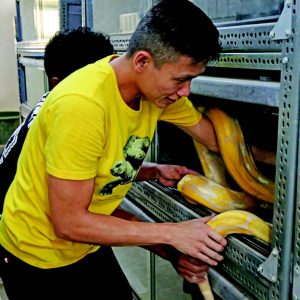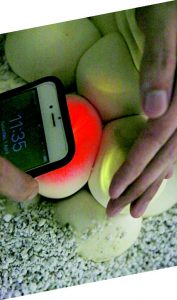Breeding reptiles is my passion. It always excites me whenever I successfully propagated them. Here is a female albino tiger reticulated python that has successfully laid her eggs. Properly coiled, firm and tight.
 I slowly open her enclosure to inspect her eggs, checking for any infertile eggs (slugs). Well, looks like we have a good clutch out of this female. She looks like a good mother, protecting her eggs nicely. The texture of snake eggs are soft and leathery.
I slowly open her enclosure to inspect her eggs, checking for any infertile eggs (slugs). Well, looks like we have a good clutch out of this female. She looks like a good mother, protecting her eggs nicely. The texture of snake eggs are soft and leathery.

Now is the time to remove the eggs from her and incubate them scientifically. The reason we want to remove the eggs from her is because we have a higher success rate of hatchling them. We don’t want to risk any infertile eggs that will soon collapse infecting the good ones.
Temperature and humidity are also big factors for these eggs. You must give the right requirement to be able to successfully hatch them. Not all reptile eggs are incubated the same, so you need to do your research first based on the species you’re working with.


First, I gauge the snake with a snake hook because they might be quite aggressive during this stage, a good mother always protect her eggs. I need to see how to untangle her safely from her eggs. We want to make sure that the mother is safe and at the same time, we don’t want to turn the eggs around. We need to make sure that the position of the eggs stays the same after removing the female from her eggs. Keep them in the same orientation as they were laid. Turning reptile eggs might actually kill the eggs.
After safely removing the female from her eggs, I secure her in another enclosure to make sure she would settle down first. Once settled, we would give her a nice bath to remove the scent of the eggs from her. We would also clean her enclosure and give her some fresh clean water, letting her rest for a few days. After resting, we would offer something for her to eat, we only give half the size of the food she normally eats. Her body is drained from laying and we want to nurse her body back to its tip-top condition. This is also one of the reasons why we separate the eggs from its mother. We don’t want to risk the life of the female. Imagine if we let her incubate the natural way for 2-3 months, her body condition will deteriorate. It’s too risky for us and we don’t want that to happen.

Inspect the eggs, making sure there are no slugs and everything is upright, in the same position as they are laid. I also check the bottom part of the eggs to see if there is any dirt or mold.
 I setup a container to incubate the eggs. There are a lot of choices for medium you could use. You can use soil, sand, vermiculite or perlite, but personally I use perlite as our incubation medium. I put 10 percent water on the perlite. We don’t want the incubation medium to be wet only moist. Too much moisture can cause bacterial, fungal and mold infestation that would harm the eggs.
I setup a container to incubate the eggs. There are a lot of choices for medium you could use. You can use soil, sand, vermiculite or perlite, but personally I use perlite as our incubation medium. I put 10 percent water on the perlite. We don’t want the incubation medium to be wet only moist. Too much moisture can cause bacterial, fungal and mold infestation that would harm the eggs.

15-18. I candle the eggs one by one to see if they are fertile. If I notice there are no veins on the eggs, I separate them carefully, since I don’t want to incubate them right next to the good eggs. Doing so would risk contamination by harmful bacteria, fungus or mold. It’s better to be safe than sorry in the end. Now it’s time to put them in our incubator and wait for them to hatch.

This appeared in Animal Scene magazine’s July 2018 issue.






